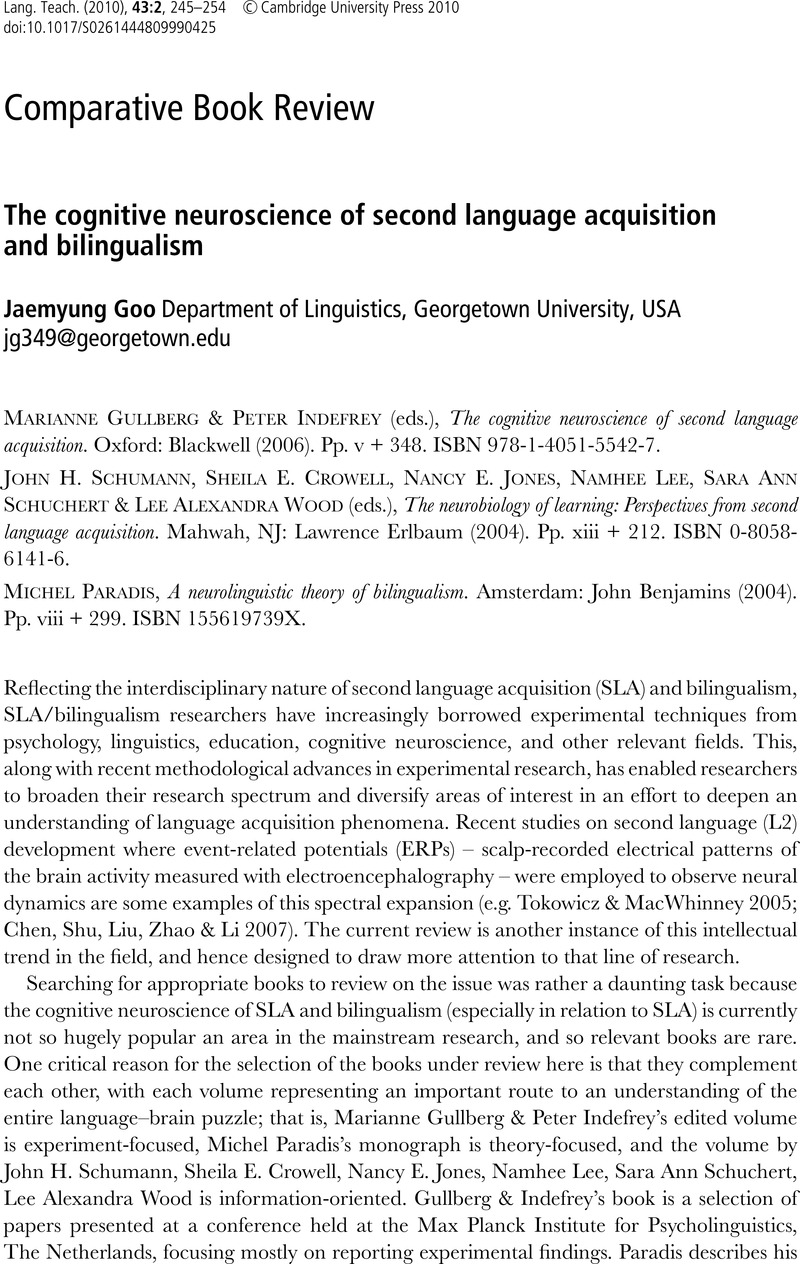No CrossRef data available.
Article contents
The cognitive neuroscience of second language acquisition and bilingualism - Marianne Gullberg & Peter Indefrey (eds.), The cognitive neuroscience of second language acquisition. Oxford: Blackwell (2006). Pp. v + 348. ISBN 978-1-4051-5542-7. - John H. Schumann, Sheila E. Crowell, Nancy E. Jones, Namhee Lee, Sara Ann Schuchert & Lee Alexandra Wood (eds.), The neurobiology of learning: Perspectives from second language acquisition. Mahwah, NJ: Lawrence Erlbaum (2004). Pp. xiii + 212. ISBN 0-8058-6141-6. - Michel Paradis, A neurolinguistic theory of bilingualism. Amsterdam: John Benjamins (2004). Pp. viii + 299. ISBN 155619739X.
Published online by Cambridge University Press: 03 March 2010
Abstract
An abstract is not available for this content so a preview has been provided. Please use the Get access link above for information on how to access this content.

- Type
- Comparative Book Review
- Information
- Copyright
- Copyright © Cambridge University Press 2010
References
Baddeley, A. D. (2007). Working memory, thought, and action. Oxford: Oxford University Press.CrossRefGoogle Scholar
Chen, L., Shu, H., Liu, Y., Zhao, J. & Li, P. (2007). ERP signatures of subject–verb agreement in L2 learning. Bilingualism: Language and Cognition 10, 161–174.CrossRefGoogle Scholar
Colom, R., Shih, P. C., Flores-Mendoza, C. & Quiroga, M. Á. (2006). The real relationship between short-term memory and working memory. Memory 14, 804–813.CrossRefGoogle ScholarPubMed
Conway, A. R. A., Jarrold, C., Kane, M. J., Miyake, A. & Towse, J. N. (eds.) (2007). Variation in working memory. Oxford: Oxford University Press.Google Scholar
DeKeyser, R. M. (1997). Beyond explicit rule learning: Automatizing second language morphosyntax. Studies in Second Language Acquisition 19, 195–221.CrossRefGoogle Scholar
DeKeyser, R. M. (1998). Beyond focus on form: Cognitive perspectives on learning and practicing second language grammar. In Doughty, C. & Williams, J. (eds.), Focus on form in classroom second language acquisition. Cambridge: Cambridge University Press, 42–63.Google Scholar
Ellis, N. C. (2005). At the interface: Dynamic interactions of explicit and implicit language knowledge. Studies in Second Language Acquisition 27, 305–352.CrossRefGoogle Scholar
Ellis, N. C. (ed.) (1994). Implicit and explicit learning of languages. London: Academic Press.Google Scholar
Ellis, R. (1994). A theory of instructed second language acquisition. In N. C. Ellis (ed.), 79–114.Google Scholar
Ellis, R. (2005). Measuring implicit and explicit knowledge of a second language: A psychometric study. Studies in Second Language Acquisition 27, 141–172.CrossRefGoogle Scholar
Engle, R. W. (2002). Working memory capacity as executive attention. Current Directions in Psychological Science 11, 19–23.CrossRefGoogle Scholar
Engle, R. W., Kane, M. J. & Tuholski, S. W. (1999). Individual differences in working memory capacity and what they tell us about controlled attention, general fluid intelligence, and functions of the prefrontal cortex. In Miyake, A. & Shah, P. (eds.), Models of working memory: Mechanisms of active maintenance and executive control. Cambridge: Cambridge University Press, 102–134.CrossRefGoogle Scholar
Engle, R. W., Tuholski, S. W., Laughlin, J. E. & Conway, A. R. A. (1999). Working memory, short-term memory, and general fluid intelligence: A latent-variable approach. Journal of Experimental Psychology: General 128, 309–331.CrossRefGoogle ScholarPubMed
Kane, M. J., Bleckley, M. K., Conway, A. R. A. & Engle, R. W. (2001). A controlled-attention view of working-memory capacity. Journal of Experimental Psychology: General 130, 169–183.CrossRefGoogle ScholarPubMed
Kane, M. J., Conway, A. R. A., Hambrick, D. Z. & Engle, R. W. (2007). Variation in working memory capacity as variation in executive attention and control. In Conway et al. (eds.), 21–48.Google Scholar
Krashen, S. (1981). Second language acquisition and second language learning. London: Pergamon.Google Scholar
Mackey, A. (2006). From introspections, brain scans, and memory tests to the role of social context: Advancing research on interaction and learning. Studies in Second Language Acquisition 28, 369–379.CrossRefGoogle Scholar
Oberauer, K., Süβ, H.-M., Wilhelm, O. & Sander, N. (2007). Individual differences in working memory capacity and reasoning ability. In Conway et al. (eds.), 49–75.Google Scholar
Oberauer, K., Süβ, H.-M., Wilhelm, O. & Wittmann, W. W. (2003). The multiple faces of working memory: Storage, processing, supervision, and coordination. Intelligence 31, 167–193.CrossRefGoogle Scholar
Paradis, M. (1994). Neurolinguistic aspects of implicit and explicit memory: Implications for bilingualism and SLA. In N. C. Ellis (ed.), 393–419.Google Scholar
Schmidt, R. (1990). The role of consciousness in second language learning. Applied Linguistics 11, 129–158.CrossRefGoogle Scholar
Schmidt, R. (1995). Consciousness and foreign language learning: A tutorial on the role of attention and awareness in learning. In Schmidt, R. (ed.), Attention and awareness in foreign language learning. Honolulu, HI: University of Hawai'i Press, 1–63.Google Scholar
Schmidt, R. (2001). Attention. In Robinson, P. (ed.), Cognition and second language instruction. Cambridge: Cambridge University Press, 3–32.Google Scholar
Tokowicz, N. & MacWhinney, B. (2005). Implicit and explicit measures of sensitivity to violations in second language grammar: An event-related potential investigation. Studies in Second Language Acquisition 27, 173–204.CrossRefGoogle Scholar




